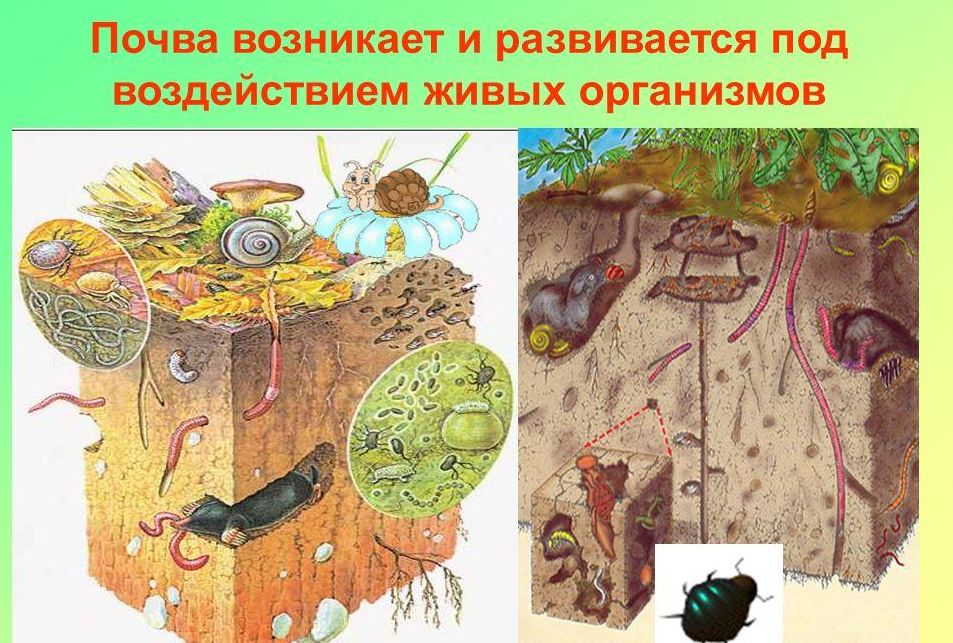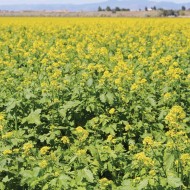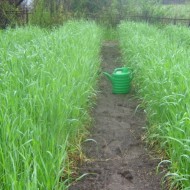How to organize organic farming in the country from scratch: popular methods and reviews
Content
What is organic farming
In modern agriculture, all kinds of artificial factors are used, such as pesticides or deep tillage. These measures allow for high yields, but have a detrimental effect on the land. As a result, over the past decades, the natural soil fertility has significantly decreased for two reasons:
- the natural cycle of substances has ceased to work;
- the number of fungi, protozoa, soil microorganisms in the ground has decreased so much that it does not particularly affect the result.

Organic farming offers to return to the origins - to the period when the fertility of the earth was determined only by the natural interaction between animals, vegetation, organic waste and natural climatic conditions. A person working on the earth should act as a helper, using only those resources that nature provides.
Foundations and principles
Let us formulate the postulates on which organic farming is based:
- The earth is a living organism with its own vital activity. The more intensively it is processed, that is, it is dug up, loosened, chemical fertilizers are applied, etc., the more effort and resources are required over time to maintain an acceptable level of efficiency. Organic farming allows you to get steadily growing yields every year, spending a minimum of resources.
- Mulching is the main way to improve soil fertility from scratch. Fallen leaves, weeds, hay and sawdust are used as mulch. Carefully covering the beds with a mulch layer, it is possible to protect black soil from erosion, loss of moisture and cold.
- Top dressing is carried out only with organic substances, which do not destroy, but contribute to the vital activity of beneficial fungi and microbes contained in the earth. These organisms process organic matter, suppress pathogenic bacteria, gradually increasing the amount of natural humus.

Agriculture according to Ovsinsky
In our country, the first ascetic of the rejection of the classical method of digging up vegetable gardens was a scientist-agronomist Ivan Ovsinsky. At the turn of the century before last, an innovative breeder wrote a scientific work "New farming system", in which he substantiated the benefits of using a minimum of a rural plow in soil preparation. According to the scientist, this technique allows obtaining high-quality and environmentally friendly products without harming the earth.
Agriculture according to the Kizima method
The engineer-physicist Glina Kizima taught mathematics at the university for many years.At one time, she became interested in summer cottage gardening, received several acres of land, on which she began to apply a scientific approach to growing various crops.
Galina Aleksandrovna has published several books in which she shared her practical experience of innovative land cultivation, which makes it possible to obtain high yields even on infertile soils. The main tenets of her practice were three "not":
- do not weed;
- do not dig;
- do not water.
The writer coined a new horticultural term "smart bed", proving the effectiveness of organic techniques from her own experience.
Video "First steps in natural farming"
After watching this video, you will know how to properly organize eco-farming on the site.
The advantages and disadvantages of eco-farming
There is some skepticism among gardeners about the idea of returning to natural farming. However, the classical method, which includes plowing, digging and steam, does not suit many - every year more and more resources have to be invested, resulting in products saturated with chemistry.
Despite the advantages, organic farming is not widely used in the national economy. They are fond of private owners of personal plots and summer cottages, who want to receive environmentally friendly products for themselves and for sale.
Let's list the main advantages of eco-farming:
- The harvest of agricultural crops is ecologically clean, with the best taste.
- The amount of weed is reduced.
- To grow a crop, abundant watering is not required, less effort, time and money is spent.
The mass adoption of the technology is hindered by some of its shortcomings:
- A sharp drop in yield in the first 1-2 seasons after a departure from the classical method. The soil from prolonged exposure to chemicals and mineral fertilizers is significantly polluted, so it needs time to fully recover.
- It is risky to transfer large areas to the new technology - there is a high risk of new diseases, pests, etc. And everything made in small quantities usually costs more.
- Over the years of traditional farming, pests have multiplied on the lands, which will have to be dealt with, since they have no natural enemies.
- From neighboring plots, where the traditional approach is still maintained, viruses and microorganisms will enter organic farming areas that organic farming cannot cope with. The same can be said about precipitation, which brings with it the spores of pathogenic organisms.

Rules for organizing natural farming in the country
The main task is to create the same conditions for plants in the garden as in the wild, making minimal interventions. In practice, this will lead to the following:
- the top fertile layer will return to its natural state;
- the natural ecosystem will be restored.
The significance of the beds
Caring for the beds using eco-technology involves the following:
- in spring and autumn, shallow loosening is carried out, covering 5–7 cm of the upper soil layer;
- feed the soil only with organic fertilizers, including manure, compost, leaf humus, green manure, wood ash, to which it is allowed to add the developments of microbiologists;
- biological products and agricultural techniques are used to protect against diseases, weeds and pests;
- alternating crops attract beneficial insects and birds that feed on pests.
You can start organizing "smart beds" at any time, but the most suitable period is autumn. The practical tricks are as follows:
- The plot is divided into small beds. Each can be processed differently, depending on the type of crops planted.
- Having marked the bed with pegs, the surface is leveled with a rake.
- The earth is protected by covering it with organic natural materials.
- The soil is mulched to a depth of 10 cm or a little more.This will reduce the number of weeds, reduce evaporation, and protect against pests and aggressive sunlight.
- Loosening is carried out with a flat cutter and only if necessary.

Population of soil with microorganisms
The more fertile the soil, the higher the yields. Humus is responsible for fertility - an organic component of the soil, which is gradually built up due to the remains of vegetation and biochemical transformations of animal products. Humus contains nutritional components of plant crops, its production involves:
- saprophytic microorganisms;
- symbiont mushrooms;
- soil fauna.
Multiple deep digging destroys well-established natural processes, the use of pesticides destroys the fauna of the earth. Rare loosening does not violate the microbiological balance, and organic fertilizers are built into the food chains of microorganisms, saturating the soil with nutrients.

Role of mulch and mulching
Soil fertility can be increased without any fertilizers just by correct mulching. Weeds and grass cuttings, fallen leaves, hay and sawdust are used as mulch.
Cover the garden bed immediately after planting the seedlings, following the rules:
- apply mulch in a thick, dense layer without sparing;
- it is allowed that the mulch comes into contact with the stems of garden crops, but it is impossible to cover the tree trunks with it - the bark will begin to rot without air access;
- as the plants grow, the mulch overheats and rots, going into the ground, from where it enters the crops in the form of organic matter, therefore, it needs to be reported about once a week;
- dry mulch is poorly absorbed, so it must be constantly watered, making sure that the layer between the soil and the mulch remains moist all the time.
In organic farming, it is not the crops themselves that need to be watered, but only the mulch laid around them. If seeds are planted in the ground, they are first allowed to germinate, and only then the beds are mulched.

Even after harvesting, the beds are not dug up, the mulch is not harvested. The site is leveled with a rake, again covered with a thick layer of new mulch and left to winter in this form. Another option is to sow the beds before winter with siderates.
The use of green manure
This is the name of plant crops, which, due to the developed root system, loosen the soil well. These include:
- oats;
- mustard;
- lupine;
- radish;
- sweet clover;
- buckwheat;
- peas.
- Mustard
- Oats
- Buckwheat
- Lupine
The roots of green manure penetrate deeply into the soil, extracting the nutrients they need from there, as a result:
- the level of acidity decreases;
- oxygen penetrates to great depths;
- weed growth is suppressed;
- some types disinfect the soil;
- the soil is saturated with nitrogen, potassium, phosphorus.
Sideration is often done in the spring, preparing the beds for sowing the main crops according to the rules:
- Sow thickly, scattering over the entire area, then sprinkle with earth or compost so that the birds do not peck the seeds.
- 2 weeks before planting the crops, the stalks of the green manure are cut and left to lie in the garden bed. In the future, they will serve as an excellent mulch.
- Seedlings or seeds are planted between them.
If sideration is carried out before winter instead of mulching, you also need to sow thickly - not all seeds will germinate. When the plants die, they will form compost, enhancing the nutrient properties of the soil.
It is important to prune siderata before they begin to self-seeding.
Fertilizers and feeding
Plants require nitrogen, potassium, phosphorus, magnesium for growth. These components are found in manure and compost. Additional organic fertilizers are peat, bone meal and bird droppings, as well as wood ash.These types of fertilizers are universal, safe for humans, do not destroy microorganisms contained in the earth and create a nutrient medium for plants.

At the disposal of our ancestors were only stove ash and manure. Unfortunately, cattle are not kept in dachas, therefore horse or even cow dung is very rare today. Poultry droppings contain a high concentration of organic matter, so you need to use it carefully.
Here is a recipe for using a liquid feed obtained from dried poultry manure:
- Stir 500 g of fertilizer in 10 l of water until smooth.
- For watering plants, the manure mass is diluted with water at the rate of 1:20.
- Pour feed under the roots, the crops themselves are not sprayed with it.
The role of crop rotation
Different plants require certain nutrients for normal growth, which they obtain from the earth. If the same crops are constantly sown in one place, the soil becomes impoverished, and yields decrease. Other problems also arise:
- pathogens that parasitize on a given culture start up in the ground;
- root secretions accumulate - colins, which inhibit the growth of other plants.
In order not to let the soil become depleted and to avoid other troubles, they resort to crop rotation, which consists in alternating planting of different crops in the same area over the years. This is done according to agrotechnical rules, given that some plants are able to saturate the soil with elements that are useful for others.

Reviews of summer residents and specialists
“On the advice of my neighbors and being a busy person, I decided to try a new method - you need to put in little effort, and the harvests promised big. In the first year, she organized a couple of organic beds in the country and did not regret it. We think in a year to start cultivating the whole garden in the same way. "
“A very neglected suburban area was left from the parents. I chose eco-farming as a method for the lazy. The neighbor laughed at first when I covered the beds with mown grass, and six months later my potato and carrot crop was one and a half times higher. "
A simple acquaintance with no-till farming allows us to conclude that it will take a little work from the gardener, you just need to be patient. Gradually, competent crop rotation, mulching and sowing of green manure will make it possible to obtain environmentally friendly crops on their own beds.




